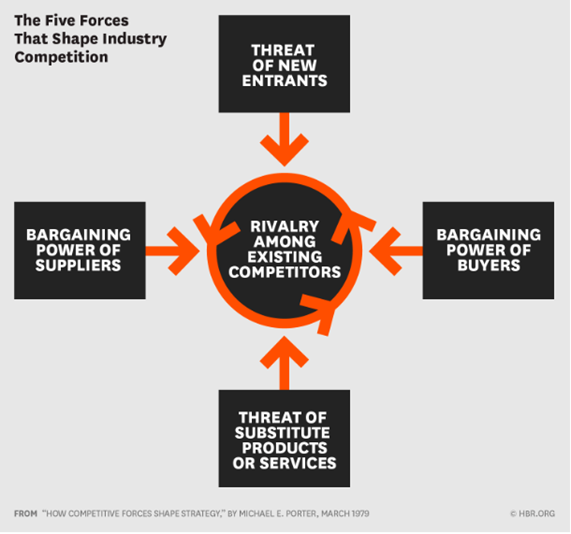At Heartland, one of our 10 Principles of Value Investing™ is identifying companies with sound business strategies. Before we can do that, though, we must understand the industries in which these firms compete. Is it fragmented with numerous rivals? Is the playing field concentrated with only a few dominant players? Is there pricing power?
It's not just about the company’s direct competitors. At Heartland, our portfolio managers are firm believers in the “Five Competitive Forces That Shape Strategy,” a theory developed by economist Michael Porter. Porter, who taught at Harvard Business School for nearly 50 years, long argued that business leaders define competition too narrowly. While companies are constantly going up against their direct rivals, they are also locked in a longer-term fight for profitability with a broader group of players.
Those four other groups include: suppliers, whose negotiating power could affect the company’s overall costs; customers of the firm’s products and services, whose bargaining strength could shape pricing power; new entrants to the industry who are threatening to come in and take demand; and makers of substitute products or services that can constrain future growth (see the image below).

Source: “How Competitive Forces Shape Strategy,” By Michael E. Porter, March 1979. ©HBR.ORG
It’s difficult to assess how sound a company’s strategy is unless we know how the business is anticipating, addressing, and counteracting all five competitive forces. To get a better sense of that, we meet with management to learn their perception of the landscape, how they are addressing competitive risks, and to gain insights on their conviction, confidence, and plans for the organization.
In our experience, certain strategies resonate and give us confidence that management is willing to make difficult choices in the short term to create meaningful shareholder value in the long run. One that frequently comes to mind is portfolio optimization, which is the willingness to divest an underperforming segment that may be facing difficult competitive challenges, even if that unit played an important role in the company’s past. Another example is the willingness to invest counter-cyclically. This is where a business, faced with near-term challenges, manages somehow to look beyond current difficulties and identifies longer-term opportunities worth investing in now. (For a good example of this, see the latest Where’s Will video, featuring Heartland CEO Will Nasgovitz).
A company’s willingness to make difficult decisions also reflects the competence of the management team, which is another one of our 10 Principles of Value Investing. Management may demonstrate this through an accelerated share buyback program or insider buying, which are good indicators of how confident the company’s leadership is on the firm’s competitive standing.
©2025 Heartland Advisors | 790 N. Water Street, Suite 1200, Milwaukee, WI 53202 | Business Office: 414-347-7777 | Financial Professionals: 888-505-5180 | Individual Investors: 800-432-7856
Past performance does not guarantee future results.
Investing involves risk, including the potential loss of principal.
Value investments are subject to the risk that their intrinsic value may not be recognized by the broad market.
There is no guarantee that a particular investment strategy will be successful.
Russell Investment Group is the source and owner of the trademarks, service marks and copyrights related to the Russell Indexes. Russell® is a trademark of Russell Investment Group.
Small-cap investment strategies, which emphasize the significant growth potential of small companies, have their own unique risks and potential for rewards and may not be suitable for all investors. Small-cap securities are generally more volatile and less liquid than those of larger companies.
The statements and opinions expressed in the articles or appearances are those of the presenter. Any discussion of investments and investment strategies represents the presenters' views as of the date created and are subject to change without notice. The opinions expressed are for general information only and are not intended to provide specific advice or recommendations for any individual. Any forecasts may not prove to be true.
Economic predictions are based on estimates and are subject to change.
Heartland’s investing glossary provides definitions for several terms used on this page.